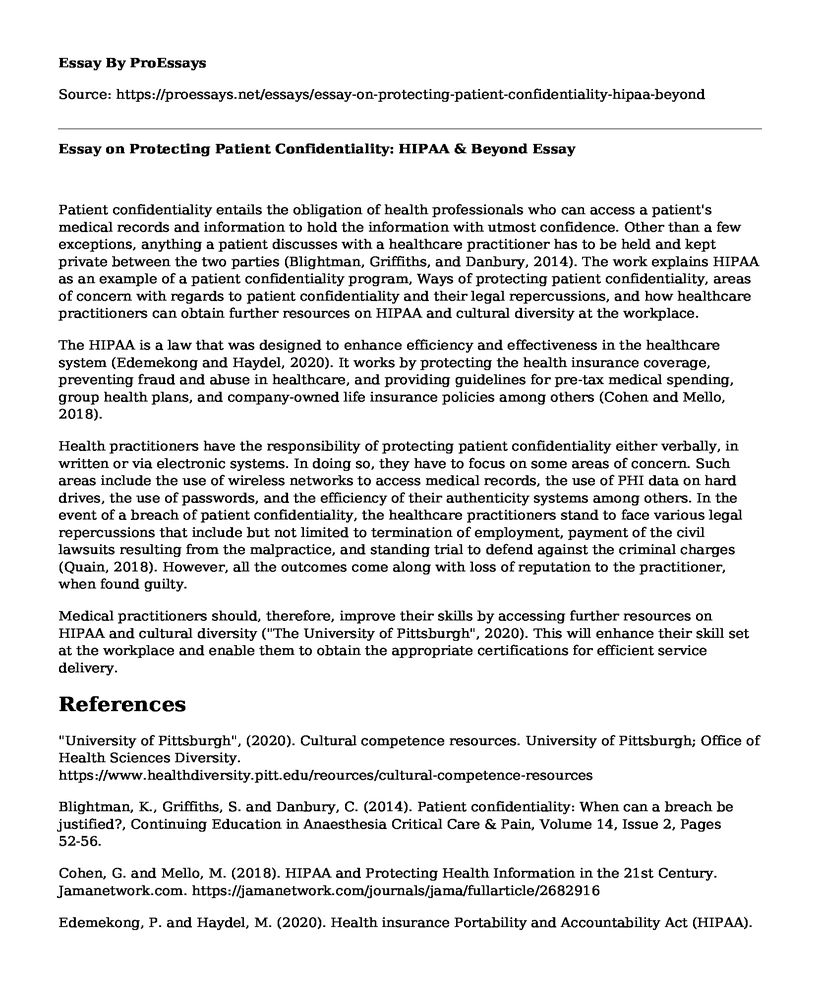Patient confidentiality entails the obligation of health professionals who can access a patient's medical records and information to hold the information with utmost confidence. Other than a few exceptions, anything a patient discusses with a healthcare practitioner has to be held and kept private between the two parties (Blightman, Griffiths, and Danbury, 2014). The work explains HIPAA as an example of a patient confidentiality program, Ways of protecting patient confidentiality, areas of concern with regards to patient confidentiality and their legal repercussions, and how healthcare practitioners can obtain further resources on HIPAA and cultural diversity at the workplace.
The HIPAA is a law that was designed to enhance efficiency and effectiveness in the healthcare system (Edemekong and Haydel, 2020). It works by protecting the health insurance coverage, preventing fraud and abuse in healthcare, and providing guidelines for pre-tax medical spending, group health plans, and company-owned life insurance policies among others (Cohen and Mello, 2018).
Health practitioners have the responsibility of protecting patient confidentiality either verbally, in written or via electronic systems. In doing so, they have to focus on some areas of concern. Such areas include the use of wireless networks to access medical records, the use of PHI data on hard drives, the use of passwords, and the efficiency of their authenticity systems among others. In the event of a breach of patient confidentiality, the healthcare practitioners stand to face various legal repercussions that include but not limited to termination of employment, payment of the civil lawsuits resulting from the malpractice, and standing trial to defend against the criminal charges (Quain, 2018). However, all the outcomes come along with loss of reputation to the practitioner, when found guilty.
Medical practitioners should, therefore, improve their skills by accessing further resources on HIPAA and cultural diversity ("The University of Pittsburgh", 2020). This will enhance their skill set at the workplace and enable them to obtain the appropriate certifications for efficient service delivery.
References
"University of Pittsburgh", (2020). Cultural competence resources. University of Pittsburgh; Office of Health Sciences Diversity. https://www.healthdiversity.pitt.edu/reources/cultural-competence-resources
Blightman, K., Griffiths, S. and Danbury, C. (2014). Patient confidentiality: When can a breach be justified?, Continuing Education in Anaesthesia Critical Care & Pain, Volume 14, Issue 2, Pages 52-56.
Cohen, G. and Mello, M. (2018). HIPAA and Protecting Health Information in the 21st Century. Jamanetwork.com. https://jamanetwork.com/journals/jama/fullarticle/2682916
Edemekong, P. and Haydel, M. (2020). Health insurance Portability and Accountability Act (HIPAA). Ncbi.nlm.nih.gov. https://www.ncbi.nlm.nih.gov/books/NBK500019/https://smallbusiness.chron.com/employee-consequences-breach-confidentiality-15476.html
Quain, S. (2018). Employee consequences for breach of confidentiality. Chron.com. https://smallbusiness.chron.com/employee-consequences-breach-confidentiality-15476.html
Cite this page
Essay on Protecting Patient Confidentiality: HIPAA & Beyond. (2023, Apr 09). Retrieved from https://proessays.net/essays/essay-on-protecting-patient-confidentiality-hipaa-beyond
If you are the original author of this essay and no longer wish to have it published on the ProEssays website, please click below to request its removal:
- Security of Healthcare Records Essay
- Flood Preparation and Evacuation in Puyallup by Pierce County Emergency Management
- Critical Incident in Social Work Essay Example
- Essay Sample on Types of Diabetes: Gestational, Juvenile and Adult-Onset Diabetes
- Responding to Emergencies: High-Rise Building Vulnerabilities - Essay Sample
- Nurse-Sensitive Indicators: Assessing Quality of Care - Essay Sample
- Nurses Empowering the World: Advocating for Patients' Rights & Wellbeing - Paper Example







